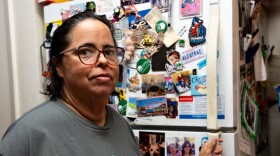NOAH ADAMS, host:
Here in Washington, the famed cherry trees are said to reach their peak at the end of this month. Thirty years ago, you had to wait until the 5th of April for cherry blossoms. While spring began yesterday, March 20th, scientists say we are seeing the signs of spring earlier and earlier, an average of eight hours earlier every year. Kirsten de Beurs is one of the scientists studying this phenomenon. She's an assistant professor of geography at Virginia Tech. She describes for us two satellite images, one from 1982 and one from 2006 that showed us how things are changing.
Dr. KIRSTEN DE BEURS (Assistant Professor, Geography, Virginia Tech): What you start to see is that the greener areas are the areas where start of season is earliest in the map, if you just look at 1982. And then, the light green, it's a little bit later, and then yellow, it's even later, and then red is very late.
ADAMS: So, we are very clearly looking at a great deal more dark green on the 2006 map than the 1982 map?
Dr. DE BEURS: Yes. If you compare 1982 with 2006, you will see that there's more dark green in 2006. And the green is standing further north, and then there's less red all the way in the north.
ADAMS: I thought, when I thought about this, I heard about this, I thought it would be spring moving from south to north. But this pretty much means spring happening all over the country eight hours earlier, wherever it may be.
Dr. DE BEURS: More or less, yes.
ADAMS: Are you gathering this information only by satellites? And how - what can the satellite actually see?
Dr. DE BEURS: What the satellite sees is reflectance variance. For example, this satellite sees red and near-red reflectance. And that's just a measure of how much vegetation is on the ground basically. And so…
ADAMS: Yeah, you know, I understood…
Dr. DE BEURS: Yes.
ADAMS: …very little of what you said. But I get the idea that if something is growing, and the satellite can see it.
Dr. DE BEURS: Yes. We have images every day and saw changes every day, and we can see that over time.
ADAMS: And are you getting information data from any other sources, from people who live in these places and can tell you…
Dr. DE BEURS: Definitely.
ADAMS: …what's blooming?
Dr. DE BEURS: Yeah, yes, definitely. So, this, of course, looking at the satellites is just one side of the story. I mean, it's the ground validation that really makes it. What we see from the satellite can be a little bit different from what we actually see on the ground. Right now, big area study is doing the ground validation, working with people on the ground. There's a Project BudBurst where you can go on the Web site, and actually fill in your own information from your own yard, if you want to. There's a lot of different citizen scientist that help us gather information. And, of course, the main thing right now is to validate our satellite data and see if what we think we see is actually happening on the ground.
ADAMS: What does it mean that spring is coming eight hours earlier every year?
Dr. DE BEURS: Well, what happens is that we see the vegetation start to occur earlier. And you can imagine that if maybe the timing of the vegetation changes, the animals have to adjust their timing as well. And that's not always very easy for them to do. And so, what could happen is that you get a mismatch between vegetation timing and, for example, the timing that the animals might - that the birds migrate or the animals breed. And…
ADAMS: But wouldn't they be adjusting?
Dr. DE BEURS: They would, but it's not necessarily said that they can adjust at the same speed as the vegetation is changing right now. And so, I mean, if you, for example, think about birds and bird breeding, right, I mean, the time that the bird is laying its egg, and the time that it's breeding, there is a different timing of the year is when the vegetation occurs. So, when it gets warmer, for example, and the vegetation starts at - the timing of the vegetation changes, it's not necessarily said that those two processes behave at the same time and at the same speed, and change at the same speed.
ADAMS: Well, should we be alarmed that spring is occurring eight hours earlier every year? Is this part of climate change, do you think?
Dr. DE BEURS: It's - it looks like that. I'm not sure if we should be alarmed by it. But it's something, certainly something that we have to kind of keep our eye on and try to understand what is happening and why it's happening.
ADAMS: That's Kirsten de Beurs, she teaches geography at Virginia Tech in Blacksburg. Transcript provided by NPR, Copyright NPR.





